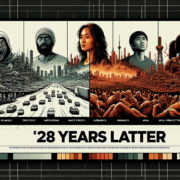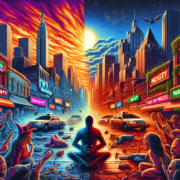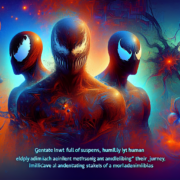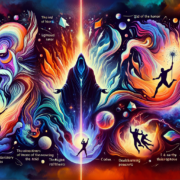
Page to Screen: 5 Epic Book-to-Movie Adaptations
Book-to-movie adaptations have become a popular trend in the entertainment industry. These adaptations involve taking a beloved book and transforming it into a film or television series. The process of adapting a book to the big screen can be challenging, but when done successfully, it can result in a captivating and visually stunning experience for audiences.
The history of book-to-movie adaptations dates back to the early days of cinema. One of the earliest examples is the 1903 silent film adaptation of Jules Verne’s “A Trip to the Moon.” Since then, countless books have been adapted into films, ranging from classic literature to contemporary bestsellers.
There are several reasons why book-to-movie adaptations are so popular. First, books often have a built-in fan base, which can help generate buzz and ensure a built-in audience for the film. Additionally, books provide rich source material that can be expanded upon and brought to life in new and exciting ways on the big screen. Finally, book-to-movie adaptations allow audiences to see their favorite characters and stories come to life in a visual medium, adding an extra layer of excitement and immersion.
Key Takeaways
- Book-to-movie adaptations have become a popular trend in the entertainment industry.
- Adapting epic novels to the big screen requires careful consideration and creative vision.
- The Lord of the Rings trilogy is a prime example of a successful book-to-movie adaptation.
- The Harry Potter series achieved phenomenal success in its adaptation to the big screen.
- Game of Thrones transformed television with its epic fantasy storytelling.
The Art of Adapting Epic Novels to the Big Screen
Adapting epic novels to the big screen can be a daunting task. These novels often have complex storylines, expansive worlds, and numerous characters, making it challenging to condense everything into a two-hour film. However, when done successfully, these adaptations can result in epic cinematic experiences that capture the essence of the original novels.
To adapt epic novels, filmmakers often employ various techniques. One common technique is condensing or streamlining the story. This involves cutting out certain subplots or characters that may not be essential to the main narrative. By doing so, filmmakers can focus on the core elements of the story and ensure that it translates well to the screen.
Another technique used in adapting epic novels is visual storytelling. Filmmakers often rely on stunning visuals and special effects to bring the world of the novel to life. This can include creating elaborate sets, using CGI to depict fantastical creatures or locations, and employing innovative cinematography techniques to capture the grandeur of the story.
There have been several successful adaptations of epic novels. One notable example is Peter Jackson’s “The Lord of the Rings” trilogy, which brought J.R.R. Tolkien’s beloved fantasy series to life on the big screen. The films were praised for their faithfulness to the source material, stunning visuals, and compelling performances. The trilogy went on to win numerous awards and became a cultural phenomenon.
The Lord of the Rings Trilogy: A Masterpiece of Book-to-Movie Adaptation
J.R.R. Tolkien’s “The Lord of the Rings” is a classic fantasy series that has captivated readers for decades. The books are known for their intricate world-building, complex characters, and epic battles between good and evil. Adapting such a beloved and expansive series was no easy feat, but Peter Jackson managed to create a cinematic masterpiece that stayed true to the spirit of the books.
One of the biggest challenges in adapting “The Lord of the Rings” was condensing the lengthy novels into a manageable film trilogy. Tolkien’s books are filled with rich detail and numerous subplots, making it difficult to include everything in the films. However, Jackson and his team were able to streamline the story while still capturing the essence of Tolkien’s world.
The success of “The Lord of the Rings” trilogy can be attributed to several factors. First, Jackson’s commitment to staying true to the source material was evident throughout the films. The attention to detail, from the costumes to the sets, helped create an immersive experience for audiences. Additionally, the films featured groundbreaking visual effects that brought the fantastical elements of the story to life.
Harry Potter Series: A Phenomenal Success in Book-to-Movie Adaptation
| Metrics | Values |
|---|---|
| Number of books in the series | 7 |
| Number of movies in the series | 8 |
| Total box office revenue of the movie series | 7.7 billion |
| Number of languages the books have been translated into | 80 |
| Number of countries where the movies have been released | over 100 |
| Number of Academy Awards won by the movie series | 15 |
| Number of actors who appeared in all 8 movies | 14 |
J.K. Rowling’s “Harry Potter” series is one of the most successful book franchises of all time. The books follow the journey of a young wizard named Harry Potter as he attends Hogwarts School of Witchcraft and Wizardry and battles against the dark wizard Lord Voldemort. The film adaptations of the series were equally successful, capturing the magic and wonder of Rowling’s world.
Adapting the “Harry Potter” series presented its own set of challenges. The books are lengthy and filled with intricate details, making it difficult to condense everything into a film. Additionally, the series had a massive fan base that had high expectations for the adaptations. However, director Chris Columbus and later directors David Yates and Alfonso Cuarón were able to bring Rowling’s world to life on the big screen.
The success of the “Harry Potter” films can be attributed to several factors. First, the films stayed true to the spirit of the books, capturing the magic and wonder that made them so beloved. Additionally, the films featured a talented cast of young actors who brought the characters to life with their performances. Finally, the films benefited from advances in visual effects technology, allowing for stunning depictions of magical creatures and spells.
Game of Thrones: The Epic Fantasy Series that Transformed Television
George R.R. Martin’s “A Song of Ice and Fire” series, commonly known as “Game of Thrones,” is a sprawling epic that has captivated readers around the world. The books are known for their complex characters, intricate political intrigue, and shocking plot twists. Adapting such a massive and beloved series for television was a monumental task, but showrunners David Benioff and D.B. Weiss were able to create a groundbreaking TV series that became a cultural phenomenon.
Adapting “Game of Thrones” presented several challenges. The books are lengthy and filled with numerous characters and subplots, making it difficult to condense everything into a television series. Additionally, the series features mature and often controversial content, which had to be handled carefully for a mainstream audience. However, Benioff and Weiss were able to navigate these challenges and create a compelling and visually stunning TV series.
The success of “Game of Thrones” can be attributed to several factors. First, the show stayed true to the spirit of the books, capturing the complex characters and intricate political machinations that made the series so compelling. Additionally, the show featured high production values, with elaborate sets, costumes, and visual effects that brought Martin’s world to life. Finally, the show benefited from a talented ensemble cast who brought the characters to life with their performances.
The Hunger Games: A Dystopian Thriller that Captivated Audiences
Suzanne Collins’ “The Hunger Games” trilogy is a dystopian thriller that has captivated readers of all ages. The books are known for their gripping storyline, strong female protagonist, and thought-provoking social commentary. The film adaptations of the series were equally successful, capturing the intensity and emotion of Collins’ world.
Adapting “The Hunger Games” presented its own set of challenges. The books are written in first-person narrative, making it difficult to translate Katniss Everdeen’s internal thoughts and emotions onto the screen. Additionally, the series features violent and disturbing content that had to be handled carefully for a young adult audience. However, director Gary Ross and later directors Francis Lawrence were able to overcome these challenges and create a compelling film series.
The success of “The Hunger Games” films can be attributed to several factors. First, the films stayed true to the spirit of the books, capturing the intensity and emotion of Collins’ story. Additionally, the films featured a talented cast, with Jennifer Lawrence delivering a standout performance as Katniss Everdeen. Finally, the films benefited from high production values, with elaborate sets and visual effects that brought the dystopian world to life.
The Chronicles of Narnia: A Classic Tale Brought to Life on the Big Screen
C.S. Lewis’ “The Chronicles of Narnia” series is a beloved classic that has enchanted readers for generations. The books are known for their imaginative world-building, memorable characters, and timeless themes. The film adaptations of the series brought Lewis’ magical world to life on the big screen, capturing the wonder and adventure of the books.
Adapting “The Chronicles of Narnia” presented its own set of challenges. The books feature fantastical creatures and locations that had to be brought to life through visual effects. Additionally, the series has religious undertones that had to be handled carefully for a mainstream audience. However, director Andrew Adamson and later directors Michael Apted and Joe Johnston were able to overcome these challenges and create visually stunning films.
The success of “The Chronicles of Narnia” films can be attributed to several factors. First, the films stayed true to the spirit of the books, capturing the magic and wonder that made them so beloved. Additionally, the films featured a talented cast who brought the characters to life with their performances. Finally, the films benefited from high production values, with elaborate sets and visual effects that brought Narnia to life.
The Girl with the Dragon Tattoo: A Dark and Gripping Story that Transcended Borders
Stieg Larsson’s “Millennium” series, starting with “The Girl with the Dragon Tattoo,” is a dark and gripping thriller that has captivated readers around the world. The books are known for their complex characters, intricate plotlines, and gritty depiction of violence against women. The film adaptation of “The Girl with the Dragon Tattoo” brought Larsson’s story to the big screen, capturing the intensity and suspense of the novel.
Adapting “The Girl with the Dragon Tattoo” presented its own set of challenges. The book features a complex and multi-layered plot that had to be condensed into a two-hour film. Additionally, the book deals with sensitive and controversial subject matter that had to be handled carefully for a mainstream audience. However, director David Fincher was able to overcome these challenges and create a dark and atmospheric film.
The success of “The Girl with the Dragon Tattoo” can be attributed to several factors. First, the film stayed true to the spirit of the book, capturing the dark and gritty atmosphere that made it so compelling. Additionally, the film featured a talented cast, with Rooney Mara delivering a standout performance as Lisbeth Salander. Finally, the film benefited from Fincher’s meticulous attention to detail and his ability to create tension and suspense.
The Da Vinci Code: A Controversial Bestseller that Became a Blockbuster Movie
Dan Brown’s “The Da Vinci Code” is a controversial bestseller that has sparked debate and intrigue around the world. The book is known for its blend of historical fact and fiction, religious symbolism, and fast-paced storytelling. The film adaptation of “The Da Vinci Code” brought Brown’s thrilling story to the big screen, capturing the mystery and suspense of the novel.
Adapting “The Da Vinci Code” presented its own set of challenges. The book features complex historical and religious themes that had to be condensed into a two-hour film. Additionally, the book’s controversial subject matter had to be handled carefully for a mainstream audience. However, director Ron Howard was able to overcome these challenges and create a gripping and visually stunning film.
The success of “The Da Vinci Code” can be attributed to several factors. First, the film stayed true to the spirit of the book, capturing the mystery and intrigue that made it so compelling. Additionally, the film featured a talented cast, with Tom Hanks delivering a strong performance as Robert Langdon. Finally, the film benefited from high production values, with elaborate sets and visual effects that brought the historical and religious elements to life.
The Power and Potential of Book-to-Movie Adaptations
Book-to-movie adaptations have the power to bring beloved stories and characters to life on the big screen. When done successfully, these adaptations can capture the essence of the original source material and create a visually stunning and emotionally resonant experience for audiences.
Throughout history, there have been numerous successful book-to-movie adaptations. From “The Lord of the Rings” trilogy to “Harry Potter” to “Game of Thrones,” these adaptations have captivated audiences and become cultural phenomena in their own right.
The potential for future book-to-movie adaptations is vast. There are countless books waiting to be brought to life on the big screen, from classic literature to contemporary bestsellers. However, it is important for filmmakers to stay true to the source material and capture the essence of what made the books so beloved in the first place.
In conclusion, book-to-movie adaptations have become a popular trend in the entertainment industry for good reason. They allow audiences to see their favorite stories and characters come to life in a visual medium, creating an immersive and captivating experience. With careful planning and attention to detail, book-to-movie adaptations have the potential to create cinematic masterpieces that will be remembered for years to come.
FAQs
What are some great books that became movies?
Some examples of great books that were adapted into movies include “To Kill a Mockingbird,” “The Godfather,” “The Lord of the Rings,” “The Shawshank Redemption,” and “Gone with the Wind.”
Why do books make good source material for movies?
Books often have well-developed characters, intricate plots, and vivid descriptions that can be translated onto the big screen. Additionally, books have a built-in fan base that can help generate buzz and interest in the movie adaptation.
Are movie adaptations always faithful to the original book?
No, movie adaptations often take creative liberties with the source material in order to make the story more visually appealing or to fit within the constraints of a two-hour runtime. However, some adaptations strive to stay as faithful to the book as possible.
Do movies based on books always perform well at the box office?
Not always. While some adaptations have been box office successes, others have failed to connect with audiences. Factors such as marketing, critical reception, and competition at the box office can all impact a movie’s performance.
Are there any upcoming movies based on books?
Yes, there are always new movies in development based on popular books. Some upcoming adaptations include “Dune,” “The Nightingale,” “The Power of the Dog,” and “The Lost City of Z.”

















